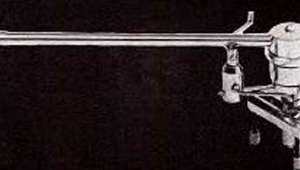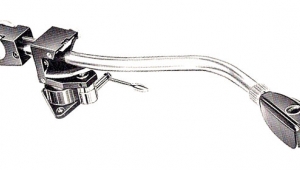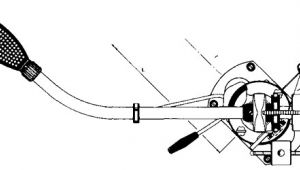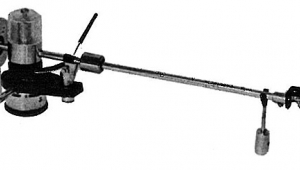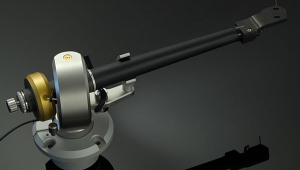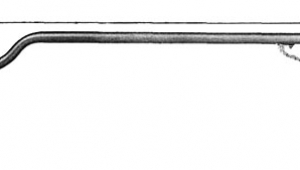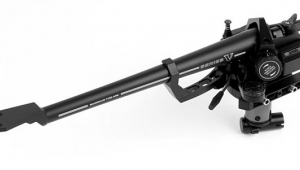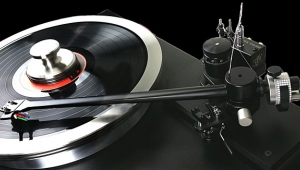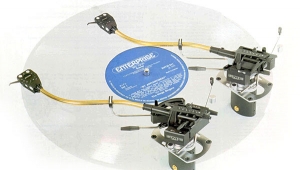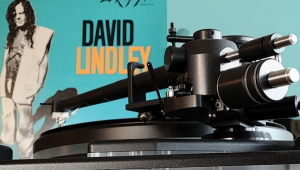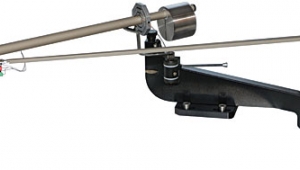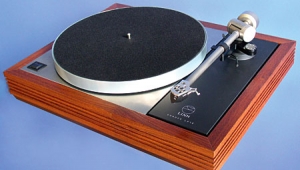| Columns Retired Columns & Blogs |
Naim Aro tonearm
When I was visiting Santa Fe last Easter (footnote 1), one of the subjects I raised with JA was Naim's ARO tonearm. This unique unipivot design has languished in Class K of Stereophile's "Recommended Components" listing for far too long. JA explained that the regular reviewers have quite enough to do, thank you, just keeping up with speakers, electronics, and especially digital. The esteemed Martin Colloms is happily using an ARO on his Linn Sondek, and wrote a review for the English magazine Hi-Fi News & Record Review in May 1991, but since there is a very small but nevertheless vociferous overlap in US readership between the two magazines, it is Stereophile policy not to have two reviews by the same reviewer of a given piece of gear.
Footnote 1: Nice folks, the Stereophile staff; my heartfelt thanks for a wonderful week to everyone I had the pleasure to meet.

When I explained that I'd been using an ARO for some time, JA asked me to review it for Stereophile—which is why someone whose writing usually appears under an "Industry Update" byline is making a surprise guest appearance in "Equipment Reports." I'll also (ab-)use the opportunity to mouth off on some unrelated topics.
Design & technology
A few years back, strange and unusual products and statements started to issue from the otherwise fairly conservative Naim company. Whereas they had always advocated rigid-bearinged tonearms and moving-coil loudspeakers, they now issued a unipivot tonearm and talked about electrostatics under development. These were the brainchildren of Guy Lamotte, a French designer who subsequently left Naim, leaving the electrostatic project unfinished; the ARO remains. Its name is taken from the precision aluminum-alloy tubing of which the main tube is made.
Unipivots have traditionally been only marginally stable, but much thought has evidently gone into the ARO's design. Lowering the counterweight to about record level has given the ARO excellent stability. This also lowers the center of gravity to below the pivot point, providing about 6dB of mechanical damping of the stylus. Another 2dB or 3dB seem to come from the bearing cup, which has a sapphire insert. The bearing is the ARO's stroke of genius. In other unipivots, a sharp pin is mounted to the turntable and the arm carries a cup which sits atop the pivot point. The ARO's arm carries the sharp tip, resting this atop a stationary cup: a true mechanical ground, and the only spiked tonearm I know of!
The headshell doesn't carry the usual slots. It is pre-drilled with three holes for the Linn Troika's and Arkiv's three-point fixing, other cartridges making use of only two of the holes provided. Naim believes that the extra structural rigidity given by a less mutilated headshell structure is preferable to the overhang adjustment possibilities afforded by the slots. Paranoids can get a good machine shop to (very, very carefully) drill some extra holes. Linn cartridges have a mounting-hole-to-stylus distance of about 7mm; in most other cartridges, this distance is about 10mm. The new holes should thus sit about 3mm behind the original ones. I must admit, I don't think overhang is all that critical an adjustment. On my own turntable, a Platine Verdier, overhang adjustments can be made by simply rotating the armboard. On other turntables, the cutout for the ARO should be made at the correct distance from the record spindle for the intended cartridge.
The ARO's alignment parameters are calculated for lower distortion on the inner grooves than those of most other arms, a claim that was borne out in practice. Due to the arm's geometry, cartridge downforce varies with elevation over the record. It should therefore be set at about record level. The (very good) manual explains this point at length; a stylus-force gauge is provided.
The arm assembly can be lifted from the turntable once a small plug for the electrical connections has been pulled. This makes cartridge mounting easy and safe.
A cueing device, the AROmatic, is available, but the arm normally comes with just a finger lift to be attached to the headshell. It takes surprisingly little time to get used to lowering the arm by hand.
Azimuth matters
Azimuth is the angle at which, viewed from the front, the stylus enters the groove; or, to be more exact, the angle between the generator coil and the groove wall, whose wiggles the coil will transform from mechanical to electrical information. If you remember that stereo LPs carry each channel's information at a 45 degrees angle from the vertical, it should be clear that an incorrect angle must mean distortion, as well as asymmetrical crosstalk. This is at least as audible as VTA.
The preferred method for setting azimuth, if your tonearm allows it, is to play a continuous tone on a test record, hook up an oscilloscope, then rotate the cartridge until the two channels' curves are as closely matched as possible. [Or with a test record offering separate left- and right-channel tracks, adjust the azimuth for equal crosstalk in each direction.—Ed.] But what do you do if you don't have access to a 'scope?
Here's a neat method I picked up from a friendly dealer (footnote 2). Get yourself an integrated amp or preamp with a mono button. Hook up one loudspeaker between the two positive outputs of the power amp; with left and right channels pushing equally hard, the speaker cone can't move, so very little sound should be heard. Play a mono record. Rotate the balance control until the least sound is heard. Release the mono button and check if the volume increases. Then rotate your cartridge until the least change in volume is heard, with or without the mono button engaged. This method works very well.
Footnote 1: Nice folks, the Stereophile staff; my heartfelt thanks for a wonderful week to everyone I had the pleasure to meet.
Footnote 2: Volker Ochsner, Phonissimo, Erftstadt-Arem, Germany.
- Log in or register to post comments
